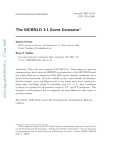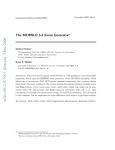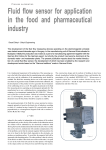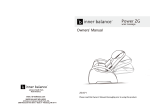Download Towards green cars
Transcript
Physics Competitions Vol. 15 No 1 & 2 2013 Towards green cars János Hegedüs Leőwey Klára High Scool Pécs; Hungary Abstract From the beginning of the 20th century many people and factories have been trying to introduce better and better environment-friendly cars. In our days there are several different types of vehicles, which can get the „Green Car” award. Which was the first car like that? Why is it good to use that kind of car? Just because its operation is cheaper? What are the benefits of using a green car? People know that they are environment-friendly vehicles, powered by alternative fuels and more expensive than other conventional internal combustion engine vehicles. I am going to give the reasons why we should speak about this topic in a secondary school, how we can bring hybrid technology into education. Then,I am going to present some parts of the development of alternative cars and to analyse the structure of the most remarkable models. Introduction Undoubtedly, the energy crisis, the air pollution and the increasing emission of greenhouse gases are among the biggest problems of the contemporary world. The primary cause of these problems is the excessive use of fossil fuels in energy production. Not only physicists, chemists and engineers have the responsibility to save the environment, and by trying to reduce the energy crisis through their new inventions, but also teachers, by making children interested in these problems. The remedy is complex, here we discuss only some issues related to the substitutes to combustion engine driven vehicles. The large scale introduction of alternative vehicles would have a positive impact on global climate change, too. Outline the problem Population and income growth are the two most powerful driving forces behind the demand for energy. According to the United Nations, the world population reached 7 billion on October 31, 2011. Nowadays, more than 250 children are born and 100 people die every minute, so in every 60 seconds the world’s population increases by 150 people! Since 1900 world population has more than quadrupled, real income has page 52 / 85 Physics Competitions Vol. 15 No 1 & 2 2013 grown by a factor of 25, and primary energy consumption by a factor of 22.5. The next 30 years are likely to see continued global integration and rapid growth of low and medium income economies. Maybe, the population growth is trending down, but we know from the statistics that the income growth is trending up. Over the last 20 years the world population has increased by 1.6 billion people, and it is projected to rise by 1.4 billion over the next 20 years. The world’s real income has risen by 87% over the past 20 years and it is likely to rise by 100% over the next 20 years. At the global level, the most fundamental relationship in energy economics remains robust – more people with more income means that the production and consumption of energy will rise. The transportation sector is second in terms of world energy use. The transportation share of total liquids consumption increases from 51% in 2006 to 56%. [1,2] But do we have enough coal, gas, oil on our planet? Is it possible to increase the production continuously? Or should we change the energy sources? There are more than 600 million motor vehicles on the streets. The biggest manufacturer is Japan, having produced 8,056,000 cars in 1998. Then the US, with 5,554,000, and Germany with 5,348,000. In course of time, these numbers experience a rapid growth. In 1960 Japan produced „just“ 185,000 cars, but by the end of the 1990s it was producing nearly 10 million a year. It is believed that at this growth rate, the number of cars on Earth will double within the next 30 years. Human life demands mobility, so we can’t organize our everyday lives without changing places. In several countries in Europe people are used to travelling 100 kilometres a day, so they can’t imagine life without transportation. Carbon dioxide is a greenhouse gas. Greenhouse gases (GHG) are those gaseous constituents of the atmosphere, both natural and anthropogenic which absorb and emit radiation at specific wavelengths within the spectrum of thermal infrared radiation emitted by the Earth’s surface, the atmosphere itself, and by clouds. This property causes the greenhouse effect. Water vapour (H2O), carbon dioxide (CO2), nitrous oxide (N2O), methane (CH4) and ozone (O3) are the primary greenhouse gases in the Earth’s atmosphere. [3,4] I only chose carbon dioxide (CO2) to analyse, but the other emitted gases show the same change in the same length of time. The analysed data and the diagram come from the official website „Carbon dioxide Information Analysis Centre” and present the major global sources of carbon dioxide (CO2) emissions from different countries, from the beginning of the Industrial Revolution to the present. [5] page 53 / 85 Physics Competitions Vol. 15 No 1 & 2 2013 Figure 1. Diagram left shows the change in the number of cars, on diagram right the global carbon dioxide emission from fossil-fuel burning is presented I have to add that the emitted carbon dioxide gas comes from transportation (20%), cement manufacture and gas flaring. When on a smoggy day we cannot see the Sun because of the air pollution, maybe everybody will feel his responsibility, and everybody will be able to grasp, we have to do something at the moment, for the future! That is not a yes or no question, there is no choice! Do we have to change our habits? - Do we need to change our cars? But better late than never! Solution (?) for the problem How can we find the good solution to reduce the air pollution and the greenhouse gas emission coming from transportation? Maybe by developing new kinds of cars, which emit less gas, or run without gas emission! But is the idea of hybrid cars a new one? The world's first hybrid car was “The Semper Vivus”, by Prof. Ferdinand Porsche, who was busy designing and developing this car as early as 1896. Four years later, when his second car the Lohner-Porsche with electrical motors first appeared in the “World Exhibition of Paris, in April 14, 1900, - it was 112 years ago - it astonished the automobile world and was an authentic novelty for the automobile fans of that time. The innovating success of this design catapulted Dr. Ferdinand Porsche to the fame as engineer. 300 Lohner Porsches were produced.” [6] Up to the 1920s a lot of manufacturers made "hybrid cars" in a very similar pattern. After this date in the transport history we cannot find any other hybrid trials until the 1960s and 1970s. What was the reason? The advances in ICE- Internal Combustion page 54 / 85 Physics Competitions Vol. 15 No 1 & 2 2013 Engine, the cheap oil and automobile production in general killed off the hybrid cars. Then, the „first” reviving hybrids appeared owing to the Arab Oil embargo. What does a green car and a hybrid car mean? We can frequently meet these expressions. But which one is correct? It seems difficult to give the answer. It is certain that all green vehicles must be environmentally friendly, so they must not produce so many harmful impacts on the environment, they reduce air pollution and greenhouse gas emission. A green vehicle can be a hybrid electric vehicle, a plug-in hybrid electric vehicle… sometimes they include just a conventional motor with high fuel economy. The real hybrid vehicle can be described as a curious mixture of an electrical vehicle and a car with an internal combustion engine. There are two different drive systems in it, where the first is the normal internal combustion engine, and the second one is the electric motor. There are more possibilities in hybrid car classification, we can make this for example according to the driving system. Nowadays the serial-hybrid and the parallel-hybrid constructions are the two most current technical solutions. Serial-hybrid vehicles are driven only by electric traction only. Due to the lack of direct drive between wheels and internal combustion engine a permanent revolution per minute can be obtained in the ICE. The internal combustion engine drives a generator, which is responsible for simultaneously supplying electricity to electric motors and batteries. In the parallel-hybrid an internal combustion engine works in conjunction with a small electric motor, 5kW to 25kW, which has to provide extra torque to the power train system in the car. When the power driving cycle is less intense, the vehicle can also utilize the engine to charge the battery pack. If our car is a parallel-hybrid, we have the possibility to turn off the internal combustion engine and use the vehicle like a completely emission free full electric vehicle. In this case the electric motor runs on the battery pack. But please note that we have electric energy only for a shorter in-town drive. If we look at the palette of hybrid cars, we will see that a lot of them are actually parallel-hybrid vehicles. The other way to classify the hybrids is by their power, sometimes we say the cars are on different degrees of hybridization. The microhybrids have less electric power, they are utilized only in parallel hybrids. A special electrical engine with a belt drive is in charge of the electric supply, and it is useful in the start-stop mechanism. The mildhybrid has more power than the microhybrid, but it is not enough to make the car move. The electric motor helps the ICE during acceleration, therefore the normal engine is calmer and needs less gasoline. page 55 / 85 Physics Competitions Vol. 15 No 1 & 2 2013 Only the full hybrid- strong hybrid- vehicles are able to move by electric power without running the internal combustion engine. When the power driving cycle is less intense- we run downhill- the potential energy will be stored in the battery. When we need more energy, during acceleration, the electric and the internal combustion engine are working together. It is always an on-board computer that adjusts the electric motor permanent depending on the thrust level. This computer has to check the battery charge status too, as the battery must not be charged less than 40%, or more than 60%. In this way the battery can actually last longer than the car itself! Conclusions- experience during the research – How can we introduce this subject to the students? You might think that nowadays it is not difficult to see hybrid vehicles, even if you do not own them. In my country you would be surprised. During the work on this topic – the hybrid car- I tried to speak to hybrid car owners, but they were unfriendly and suspicious, I was turned down many times. To get information about the car was a mission impossible! I was at the point of giving up, when fortunately I was helped by a really good colleague, who turned out to have such a car herself. We had a test drive, I was lucky enough to look under the hood, I found the high voltage units, and the warning cautions. Sitting in the car I felt I was in a SCI-FI. It is useful to read the user’s manual of a hybrid car, it is really informative. We must learn how to drive hybrids. Without a manual the owner can have some serious problems, too, the owner can even cause damage to the car. [7,8] In the car salons the sellers could not give any additional information about the technology, they were able to read the papers behind the windscreen. They told me I should buy a car with normal combustion engine… (I was in 12 car salons- and I found just one where they suggested buying a hybrid car.) In the abstract I wrote “Not only physicists, chemists and engineers have the responsibility to save the environment, and by trying to reduce the energy crisis through their new inventions, but also teachers, by making children interested in these problems.” Teachers have an important role not only in teaching, but in the environmental education. In school we must speak about the energy consumption, about the greenhouse gases, and about the climate change. Students do not gather enough information at home. Even if they receive information from the media about air pollution or the greenhouse effect, maybe they do not realize their relevance. If we don’t show them a way to environment friendly life, they will never have a green attitude. They will simply live like the other thousands of millions of people in a consumer society, who start and stop their ICE cars several times day by day. The striking facts and interesting details of technology collected in the present paper may serve as a good starting point for elaborating on this aspect of environmental education. page 56 / 85 Physics Competitions Vol. 15 No 1 & 2 2013 Acknowledgements Very special thanks go to Eszter Viszlai-Nagy for English translation, and special thanks go to Dr. Mátyás Koniorczyk, Dr. Tamás Tasnádi for their professional help. References [1] Herwig Birg. World Population Projections for the 21st. Frankfurt, Campus Verlag, Ny St.martins Press, 1995 [2] articles.economictimes.indiatimes.com [3] Tilling, Stephen. Ozone and the Greenhouse Effect A Practical G.C.S.E. Coursework Guide (ISBN: 1-85153-819-4) [4] www.ipcc.ch [5] http://cdiac.ornl.gov/ [6] Zoltán Ocskay. Lohner – Porsche, Semper Vivus. Veterán/The oldtimers, Budapest (2011) [7] Toyota group. Owner’s manual [8] Toyota group. Quick Reference Guide: Toyota hybrid-Printed in the USA (1/08) — page 57 / 85


























![FLM HD18 [v08]](http://vs1.manualzilla.com/store/data/005664321_1-9e0d84f2b9cac33a4ebfb5904f0dafa1-150x150.png)
